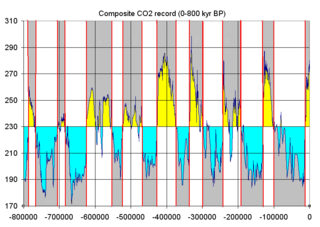빙하기
Glacial period빙하기(혹은 빙하기 또는 빙하기)는 빙하기 내의 시간 간격(수천년)으로, 기온이 낮아지고 빙하가 발달하는 것을 특징으로 합니다.반면에, 간빙하는 빙하기 사이의 따뜻한 기후의 시기이다.마지막 빙하기는 약 15,000년 [1]전에 끝났다.홀로세기는 현재의 간빙하이다.지구에 빙하가 없는 시기는 온실 기후 [2][3][4]상태로 여겨진다.
제4기
현재 약 260만년 전에 시작된 제 4차 지구에는 많은 빙하와 [5]간빙하가 존재해 왔다.지난 74만 [6]년 동안만 적어도 8번의 빙하가 발생했다.
후기 빙하기
PGP는 마지막 빙하기 이전에 발생한 빙하기이다.그것은 약 194,000년 전에 시작되었고 135,000년 전에 Eemian [7]간빙기의 시작과 함께 끝이 났다.
마지막 빙하기
마지막 빙하기는 4차 빙하기 중 가장 최근의 빙하기였다.그것은 약 11만년 전에 시작되어 약 15,000년 [1]전에 끝난 갱신세에 발생했다.빙하기 동안 발생한 빙하는 북반구의 많은 지역을 포함하며 지리적 분포에 따라 다른 이름을 가지고 있다.위스콘신(북미), 데벤시안(영국), 미들랜지안(아일랜드), 뷔름(알프스), 바이셀(중앙유럽 북부), 달리(동중국), 베이예(북중국), 타이베이(산시) 뤄지산(서남부 쓰촨성)(칠레에서).빙하 진전은 약 26,500 BP의 마지막 빙하 최대치에 도달했다.유럽에서는 빙상이 독일 북부에 도달했다.지난 65만 년 동안, 빙하의 진행과 후퇴는 평균 7번 반복되었습니다.
다음 빙하기
궤도 변화는 예측할 [8]수 있기 때문에 궤도 변화를 기후와 연관짓는 컴퓨터 모델은 미래의 기후 가능성을 예측할 수 있다.Berger와 Loutre의 연구는 현재의 따뜻한 기후가 50,000년 [9]더 지속될 수 있다는 것을 암시한다.지구의 해양과 대기로 방출되는 열 포획 가스의 양은 다음 빙하기 기간을 50,000년 [10][11]더 지연시킬 수 있다.
레퍼런스
- ^ a b J. Severinghaus; E. Brook (1999). "Abrupt Climate Change at the End of the Last Glacial Period Inferred from Trapped Air in Polar Ice". Science. 286 (5441): 930–4. doi:10.1126/science.286.5441.930. PMID 10542141.
- ^ Bralower, T.J.; Premoli Silva, I.; Malone, M.J. (2006). Bralower, T.J; Premoli Silva, I; Malone, M.J (eds.). "Leg 198 Synthesis : A Remarkable 120-m.y. Record of Climate and Oceanography from Shatsky Rise, Northwest Pacific Ocean". Proceedings of the Ocean Drilling Program. Initial Reports. Proceedings of the Ocean Drilling Program. Proceedings of the Ocean drilling program. 198: 47. doi:10.2973/odp.proc.ir.198.2002. ISSN 1096-2158. Retrieved April 9, 2014.
- ^ Christopher M. Fedo; Grant M. Young; H. Wayne Nesbitt (1997). "Paleoclimatic control on the composition of the Paleoproterozoic Serpent Formation, Huronian Supergroup, Canada: a greenhouse to icehouse transition". Precambrian Research. Elsevier. 86 (3–4): 201. Bibcode:1997PreR...86..201F. doi:10.1016/S0301-9268(97)00049-1.
- ^ Miriam E. Katz; Kenneth G. Miller; James D. Wright; Bridget S. Wade; James V. Browning; Benjamin S. Cramer; Yair Rosenthal (2008). "Stepwise transition from the Eocene greenhouse to the Oligocene icehouse". Nature Geoscience. Nature. 1 (5): 329. Bibcode:2008NatGe...1..329K. doi:10.1038/ngeo179.
- ^ Gibbard, P.; van Kolfschoten, T. (2004). "Chapter 22: The Pleistocene and Holocene Epochs" (PDF). In Gradstein, F. M.; Ogg, James G.; Smith, A. Gilbert (eds.). A Geologic Time Scale 2004. Cambridge: Cambridge University Press. ISBN 978-0-521-78142-8.
- ^ Augustin, Laurent; et al. (2004). "Eight glacial cycles from an Antarctic ice core". Nature. 429 (6992): 623–8. Bibcode:2004Natur.429..623A. doi:10.1038/nature02599. PMID 15190344.
- ^ Nehme, Carole; Verheyden, Sophie; Breitenbach, Sebastian F.M.; Gillikin, David P.; et al. (July 2018). "Climate Dynamics During the Penultimate Glacial Period Recorded in a Speleothem from Kanaan Cave, Lebanon (central Levant)" (PDF). Quaternary Research. 90 (1): 10–25. Bibcode:2018QuRes..90...10N. doi:10.1017/qua.2018.18. S2CID 134924228.
- ^ F. Varadi; B. Runnegar; M. Ghil (2003). "Successive Refinements in Long-Term Integrations of Planetary Orbits". The Astrophysical Journal. 592 (1): 620–630. Bibcode:2003ApJ...592..620V. doi:10.1086/375560.
- ^ Berger A, Loutre MF (2002). "Climate: An exceptionally long interglacial ahead?". Science. 297 (5585): 1287–8. doi:10.1126/science.1076120. PMID 12193773. S2CID 128923481.
- ^ Tyrrell, Toby (16 November 2007). "Calcium Carbonate Cycling in Future Oceans and its Influence on Future Climates". Journal of Plankton Research. 30 (2): 141–156. doi:10.1093/plankt/fbm105.
- ^ Ganopolski, A.; Winkelmann, R.; Schellnhuber, H. J. (14 January 2016). "Critical Insolation–CO2 Relation for Diagnosing Past and Future Glacial Inception". Nature. 529 (7585): 200–203. Bibcode:2016Natur.529..200G. doi:10.1038/nature16494. PMID 26762457. S2CID 4466220.



